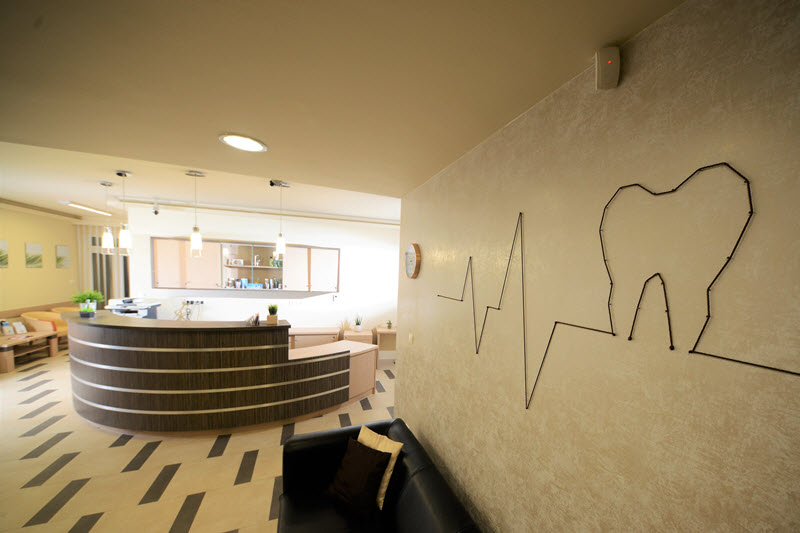

Implantation, as intervention Implantation is an essential part of modern dentistry. It provides the possibility to replace one or more teeth, even in case of complete toothlessness (edentulism) by preparing aesthetic and functional perfect, fixed or removable dentures. A dental implant is a titanium post (like a tooth root) that is surgically positioned into the jawbone beneath the gum line that allows your dentist to mount replacement teeth or a bridge into that area. Titan doesn’t corrode or irritate the surrounding tissue, it is biocompatible, therefore it inserts perfectly into the bone tissue. In case of the replacement of one tooth a crown can be placed, in case of more teeth inserted dental implants can be function as stable and reliable pillars for dental bridges or even a complete set of teeth / denture. The implant-supported dentures resemble the aesthetic of natural teeth the most, they are able to assume the role of the lost teeth and their capacity is the same.

Oral-surgical procedures are such interventions, which are necessary for the dental, orthodontic and surgical solution of oral cavity disease. These include for example complicated tooth extractions, the removal of a broken tooth or tooth root, or of a wisdom tooth. The radisectomy (tooth root resection), carried out in order to save the tooth, the removal of cysts, closure of the maxillary sinus, bone replacement procedures and implantation require oral-surgical interventions, as well.

Missing several teeth can severely influence your daily life. It can affect your general health, your appearance and self-esteem. It can start affecting your appearance, your oral health and even your health in general, so it has many negative affects. Missing teeth disturb the interplay between teeth and bone. Because gum and bone are no longer stimulated well enough due to the missing tooth, the jaw bone starts shrinking and the gum pulls back. This may weaken neighbouring teeth until they collapse. Teeth in the opposite jaw can then start growing into the gap. Even speech disorder may occur. There are several ways in connection with dentures, depending on the type and place of missing tooth. Dental crowns are used if there is no missing tooth yet, but the tooth crown is damaged due to tooth decay, trauma, abrasion or erosion, that the problem can’t be solved by a dental filling. .

The basis of this crown is a nickel-free, hypoallergenic metal frame, which is fused by porcelain. Porcelain-fused-to-metal dental crowns can be colour matched to your adjacent teeth. Next to all-ceramic crowns, porcelain-fused-to-metal crowns look most like normal teeth. Thanks to great high-load bearing these type of crowns are extremely durable, their price is more favourable than in case of zirconium crowns, but they’re less aesthetic: even by choosing the most perfect cover layer, a fully natural replica of natural teeth can’t be achieved. Zirconium bridges similar to zirconium crowns are completely free of metal, therefore they don’t cause any allergic reaction and get along well with your body. Patients who want aesthetic artificial teeth for themselves prefer choosing zirconium bridges. They blend in with your natural teeth, no one will be able to tell the difference between your replacement teeth, and the ones you already have. The adjacent teeth or implants are both suitable as a support.

Filling a tooth is necessary when there is a deficit in its structure. The cavity damages not just the one tooth, but it can spread and damage the neighbouring teeth too. The lack of tooth structure can be a result of physical impact (abrasion, cracking, etc.) or chemical effect (dental decay). The enamel of the teeth becomes vulnerable and permeable which causes the dentin (one of the hard tissues of the tooth) to outcrop to some extent resulting in sensitivity, pain or inflammation. It isn't just the sensitivity that may cause problems, the bacteria that reaches the dentin can also bring on complications, so filling the affected teeth is inevitable.

Tooth discoloration can be the result of a great number of things. Dental plaque, coffee, tea, tobacco, or failure to properly brush your teeth can all lead to external discoloration, but in some cases, it can be easily corrected with dental cleaning. Internal discoloration can be caused by certain antibiotics, the abnormity of the enamel and the dentin, root canal treatment, etc.
A fogínygyulladás leggyakoribb kiváltó oka a fogkő. A fogkő a fogakon maradt dentális plakk, azaz a lepedék elmeszesedése. A nyálban található ásványi anyagok a lepedék hatására kicsapódnak és egy megkeményedett réteget hoznak létre, amelyet fogmosással eltávolítani már nem lehet.

A sikeres kezelések egyik legfontosabb alapfeltétele az, hogy a kezelőorvos tiszta és egyértelmű képet kapjon fogainak állapotáról. A precíz diagnózis különösen fontos az implantátumok beültetése, a csontpótló beavatkozások végzése, az egyes fogágybetegségek kezelése és a szájsebészeti beavatkozások területén.
Rendelőnkben egy új technológia teszi teljessé a digitális diagnosztikát: a Vatech Pax-i 3D digitális panoráma röntgen berendezés beépített CT-vel. Ez a modern technológiára épülő korszerű diagnosztikai eszköz lehetővé teszi a legpontosabb diagnózis felállítását és a személyre szabott kezelések megtervezését.

Rendelőnkben alkalmazunk lézert is a fogászati kezelések során, mely eljárás a következő előnyökkel jár:


3 Károly Street
9200 Mosonmagyaróvár
Our clinic has its own parking.
+36-96/576 534
+36-96/576 534
info@praxisdent.com